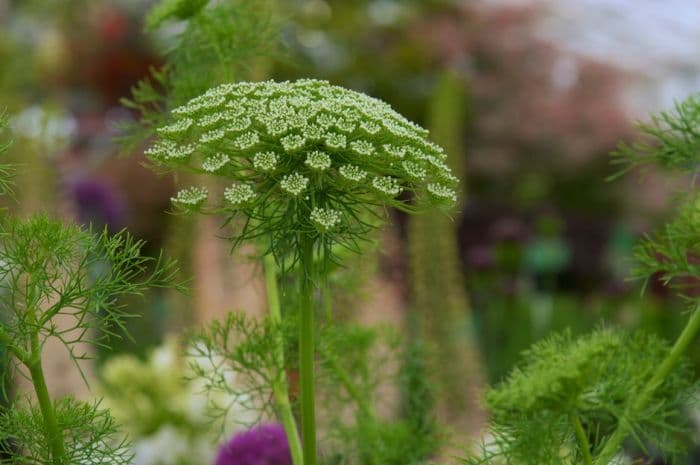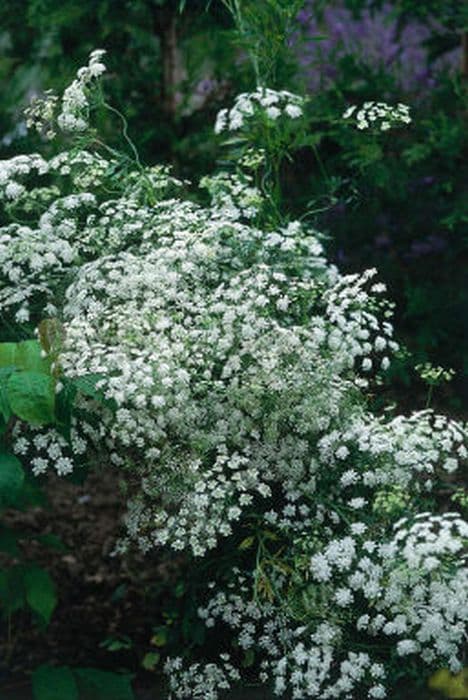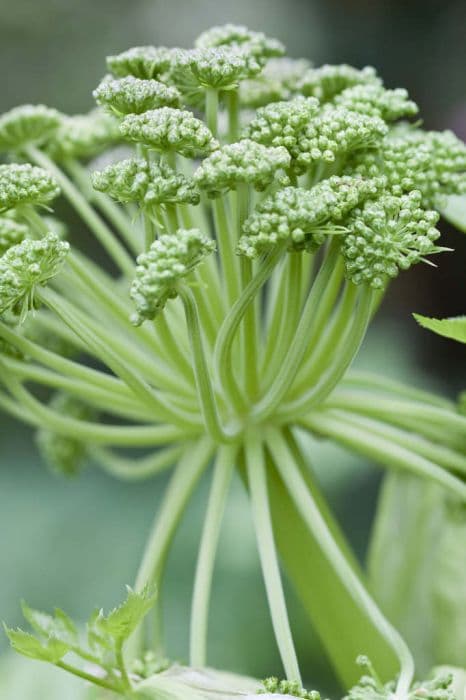Khella Visnaga daucoides

ABOUT
The plant commonly known as Khella has distinctive features that make it recognizable. It typically has finely divided, feathery leaves that create a delicate, lace-like appearance. The leaves are usually bright green, adding a vibrant touch to the foliage. During the blooming season, Khella produces distinct flower clusters that are tightly packed and can resemble an umbrella in shape. These clusters, often white to pale yellow, are made up of numerous tiny flowers and are supported by a sturdy stem. The seeds of Khella are elongated and narrow, a characteristic that has been noticed in its use in various applications. The overall impression of Khella is one of an intricate and delicately structured plant, with components that are both visually pleasing and practically significant in different contexts.
About this plant
 Names
NamesFamily
Apiaceae
Synonyms
Khella, Bishop's Weed, Toothpickweed, Ammi Visnaga
Common names
Ammi visnaga, Daucus visnaga, Visnaga vulgaris, Ammi dilatatum, Selinum visnaga, Carum visnaga, Ammi daucoides, Apium visnaga, Trinia glauca.
 Toxicity
ToxicityTo humans
Visnaga daucoides, commonly known as Khella, is not generally regarded as toxic to humans. However, it's important to note that plants can have varying effects on different individuals, and it's always best to exercise caution and avoid ingesting plants without proper knowledge of their edibility and potential effects. If a person suspects poisoning from any plant, they should seek medical attention immediately.
To pets
Khella is not typically listed as a toxic plant to pets, but as with humans, caution should be exercised. Pets may react differently to various plants and substances, and individual animals may have specific sensitivities. If you suspect your pet has ingested Khella and is showing signs of illness, contact your veterinarian promptly. Symptoms of plant poisoning in pets can vary but may include vomiting, diarrhea, drooling, or lethargy.
 Characteristics
CharacteristicsLife cycle
Biennials
Foliage type
Deciduous
Color of leaves
Green
Flower color
White
Height
2-3 feet (0.6-0.9 meters)
Spread
1-2 feet (0.3-0.6 meters)
Plant type
Herb
Hardiness zones
7
Native area
Mediterranean
Benefits
 General Benefits
General Benefits- Landscape Ornamentation - Visnaga daucoides, commonly known as Khella, offers unique aesthetic appeal with its lacy umbels and can serve as a decorative element in gardens and landscapes.
- Ecological Support - The plant provides habitat and food for various insect species, contributing to biodiversity and ecological balance.
- Drought Resistance - Khella is known for its drought tolerance, making it suitable for xeriscaping and arid climate landscaping where water conservation is important.
- Soil Stabilization - Its root system helps to stabilize the soil, preventing erosion and aiding in land recovery in degraded areas.
- Cultural Significance - It has historical uses and significance in certain cultures, which can be preserved and celebrated through its cultivation.
 Medical Properties
Medical Properties- Diuretic: Visnaga daucoides has been used to promote the production of urine.
- Antispasmodic: Traditionally utilized to relieve spasms of the muscles.
- Vasodilatory effect: Employed to widen blood vessels and improve blood flow.
- Lithotriptic: Used to help dissolve and remove kidney stones.
 Air-purifying Qualities
Air-purifying QualitiesThis plant is not specifically known for air purifying qualities.
 Other Uses
Other Uses- Visnaga, commonly known as Khella, can be used as a natural insect repellent due to its strong scent which is unpleasant to many types of insects.
- Khella has been historically used in traditional dyeing processes, offering varying shades of yellow depending on the treatment of its extract.
- The dried stalks of Khella have been utilized as toothpicks or as skewers for small kebabs due to their sturdy nature.
- Its seeds can be used in the creation of jewelry, such as necklaces or bracelets, especially in regions where the plant is native.
- The hollow stems of Khella can be fashioned into simple musical instruments, like flutes, by traditional craftsmen.
- Kitchen gardens sometimes include Khella for its potential as a companion plant; it is believed to enhance the growth of some vegetables through underground chemical interactions.
- Khella has been used in basketry and as a binding material for small crafts due to the flexibility and strength of its stems when green.
- In some cultures, Khella is incorporated into ceremonies and is burnt as incense for its aromatic properties that are considered to have spiritual significance.
- Its strong-scented oil can be extracted and used as a natural fragrance in the creation of perfumes or scented candles.
- The plant can serve an ornamental purpose in xeriscaping and dry gardens due to its resistance to drought and unique appearance.
Interesting Facts
 Feng Shui
Feng ShuiThe Khella plant is not used in Feng Shui practice.
 Zodiac Sign Compitability
Zodiac Sign CompitabilityThe Khella plant is not used in astrology practice.
 Plant Symbolism
Plant Symbolism- Protection: Visnaga daucoides, commonly known as Toothpick-plant, has been used traditionally to create amulets thought to protect against evil.
- Healing: The plant has medicinal properties and thus symbolizes healing and relief from ailments.
- Support: With a robust structure, the Toothpick-plant suggests support and strength, implying emotional or physical backing in tough times.
 Water
WaterFor Khella or Toothpickweed (Visnaga daucoides), ensure a steady watering routine that keeps the soil consistently moist but not waterlogged. During the growing season, water the plant thoroughly once a week with roughly 1 to 2 gallons of water, depending on the size of the plant and the environmental conditions. In hot or windy weather, you may need to water more frequently to maintain moisture levels. Reduce watering in the winter months when the plant is dormant. Always check the top inch of the soil for dryness before watering to avoid overwatering.
 Light
LightKhella, commonly known as Toothpickweed, thrives in full sun to partial shade locations. The best spot for this plant is where it can receive at least six hours of direct sunlight per day. However, in extremely hot climates, it may benefit from some afternoon shade to prevent scorching. Position the Toothpickweed in a spot with consistent exposure to bright light for optimal growth.
 Temperature
TemperatureKhella, known commonly as Toothpickweed, prefers a wide range of temperatures, from approximately 40 to 90 degrees Fahrenheit. It can survive minimal frost but may be damaged or killed by prolonged exposure to temperatures below freezing. The ideal temperature for growing Toothpickweed is between 60 and 75 degrees Fahrenheit for vigorous growth and good health.
 Pruning
PruningPruning Khella, also known as Toothpickweed, is necessary to remove dead or damaged stems and to promote a bushier growth habit. It is best to prune during the late winter or early spring before new growth begins. Prune Toothpickweed by cutting back up to one-third of the plant's height, and remove any dead flower stalks after blooming to maintain a tidy appearance and encourage further flowering.
 Cleaning
CleaningAs needed
 Soil
SoilKhella grows best in well-draining soil with a neutral to slightly alkaline pH level, around 7.0 to 7.5. A mix of garden soil, sand, and peat or compost should serve it well, ensuring that moisture is maintained but not excessive.
 Repotting
RepottingKhella does not typically require frequent repotting and can be repotted every two to three years as it grows. It’s important to ensure that the new pot has sufficient drainage.
 Humidity & Misting
Humidity & MistingKhella thrives in an environment with moderate humidity levels. It is not particular about humidity and can adapt to indoor conditions, but it should not be exposed to excessively dry air for prolonged periods.
 Suitable locations
Suitable locationsIndoor
Place Khella in bright, indirect light and maintain room temperature.
Outdoor
Plant Khella in full sun to partial shade in well-drained soil.
Hardiness zone
3-9 USDA
 Life cycle
Life cycleVisnaga daucoides, also known as khella, begins its life as a seed, which germinates after falling onto adequately moist soil, typically in the spring. The plant quickly establishes a rosette of pinnate leaves at the soil surface. As it matures, the stem elongates, and the plant enters the vegetative stage, characterized by further leaf development and growth in preparation for flowering. Flowering occurs in the summer, with khella producing characteristic white or pale green umbels that attract pollinators for sexual reproduction. After pollination, seeds develop within the fruiting structures, mature, and are eventually dispersed by wind or animal activity. The plant completes its life cycle either as an annual or biennial, dying after seed maturation, with new plants growing from the dispersed seeds in the following season.
 Propogation
PropogationPropogation time
Spring to Summer
The most popular method of propagation for Visnaga daucoides, also commonly known as khella, is through seeds. Seed propagation is typically done in the spring after the last frost when soil temperatures have reached a consistent 60 to 70 degrees Fahrenheit (15.6 to 21.1 degrees Celsius). To propagate khella from seeds, plant the seeds directly into well-draining soil at a shallow depth, covering them lightly with soil. Ensure the planting site receives full sunlight and maintain consistent moisture without overwatering. Seedlings will emerge in a couple of weeks, and once they are large enough to handle, they can be thinned out or transplanted to their final growing positions. This method allows for the natural variation in the species to manifest and can be an easy and cost-effective way to produce numerous plants.









